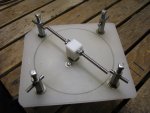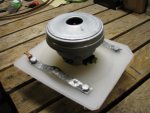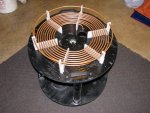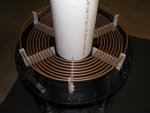I'd like to wrap this project up by mid December but I have been working long hours at work + travel.
So I've used a caliper and after lots of adjustments ive found .250in the gaps(each gap has .25in) wont quite fire unless I turn on the blower. HOWEVER, I might have gone over kill on the blower.. My reason for buying such a large blower was because I was only using 4 tungsten electrodes and I wanted to keep them cool and quenched but as the gap widened the arc started to wander.
NOTE its not a solid arc but every few seconds it would flash over to the other electrode as seen with red arrows.
few options.
first option would be spreading the terminals further apart. I tried using a quick barrier but it just arc across diagonally to the adjacent terminal.
second would be using a fan with a lower CFM.
without a variac is there anyway to dial down the blower?
ideas?












